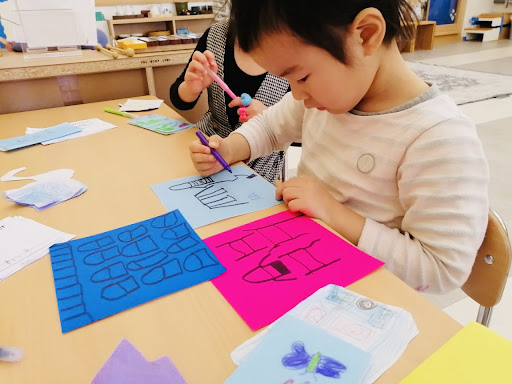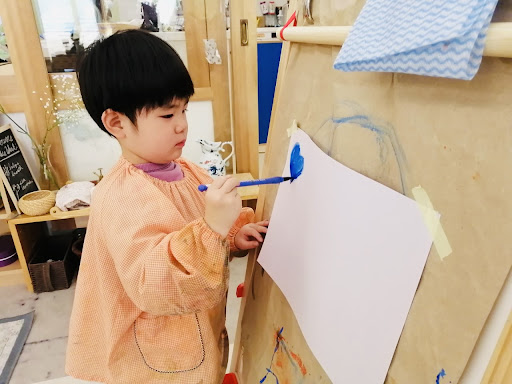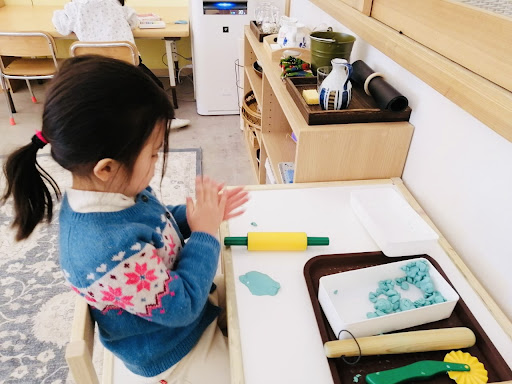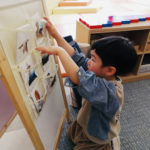
The Montessori classroom environment encourages true creativity in children through offering a variety of art materials to explore as well as innumerable opportunities to develop their hand coordination and strength through indirect practice.
By “true creativity” we mean creativity that comes from the heart and is purely child-led and not inspired by an adult idea or direction. In our classroom, a truly creative moment is a child focusing on their drawing, painting, or constructing, who is usually silent but sometimes singing to themselves or chatting with a friend while they work. They almost never ask for adult help and potentially don’t even show the drawing to the adult because their inner satisfaction is so high. When our children are experiencing true creative moments, we try hard not to interrupt them for it is here that their creativity and confidence blossoms.
So how do we foster true creativity in the Montessori classroom?

Focus on real world experiences for the child to use as inspiration.
Just as adult artists tend to take “inspiration walks” to spur creativity, children also need real life experiences to base their artwork on. These moments need not be luxurious or cost a lot of time and money, a simple walk to the park as a class and a chance to talk about the shapes of the tree leaves or the bugs they find can inspire an artwork. Since our school is located in an urban environment, a walk down the street to find trams, trains, buses and taxis will often result in a highly detailed drawing of such vehicles when we get back to school. Of course, the lived experiences of our students outside of school may inspire artistic projects as well. A trip to the grocery store and then cooking dinner together with their family may inspire a food painting session the next day at school. For a child under 5 years old, it is through cementing their understanding of the real world that their internal creativity flourishes.

Introduce how to use various art materials, but don’t show what exactly to make with them.
In our Montessori classroom, art materials, such as watercolor paints, clay, and pastels, are introduced to the child by the adult showing them how to set up their paper and supplies and then making a simple mark on the page or molding a simple shape as with clay. We don’t demonstrate an ornate design because then the child will think that is all we can do with the material. In fact, we don’t want them to copy the adult version of something! We want them to create their own design. Once these materials have been introduced, we leave them accessible to the child at any time so when the creative urge strikes, they can satisfy it without the adult’s help.
In our classroom, we also offer blank paper for drawing, origami, and even recycled materials such as milk and egg cartons for children to use to make their own creations. It is always amazing to see what they come up with!
When we do offer particular crafting projects, we put it on the shelf and children can choose whether or not to make it. We try to make the crafts as open-ended as possible so children can insert their own creative ideas into the process.

Offer opportunities to control and coordinate the hand
There are few things more frustrating for the first plane (0-6 year old) child than to have an idea in their head that they are physically incapable of bringing to life. This is usually due to the fact that their hand coordination and control is lacking behind their intellectual abilities! Giving the child many chances to indirectly prepare their hand will aid in their ability to create. Some things you can do at home (and many also happen to be lessons in a 3-6 Montessori classroom!) to increase hand strength and coordination are:
- Squeezing water out of a sponge and then using it for cleaning
- Wringing water out of a cloth
- Pouring water from a pitcher to a glass
- Scrubbing small clothes with a washboard
- Watering plants
- Sewing
- Working with puzzles (such as the puzzle maps) with knobs to practice pincer grip
- Punching paper with an awl
- Building with clay
- Color tablets (for matching colors and building an aesthetic sense/color awareness)

Emphasize the process over the product
In our Montessori classroom, we focus on the child’s creative process and their personal sense of pride over their work. When we are asked to comment on a child’s art, you will hear guides saying things like:
- “Wow, you worked so hard on that painting!”
- “I love how many colors you used in your drawing.”
- “I can see you’ve been drawing many trains recently, what’s your favorite type of train to draw?”
- “That’s such an interesting design you made with clay, can you tell me about what you made?”
- “I can really see the expression clearly on the person’s face that you drew.”
All of these comments are open-ended and either give a specific comment about the technique the child used (but not saying whether it is “good” or “bad”), complimenting the child on how hard they worked, or asking questions about what the child thinks about their art. If we want to foster creativity, we should be more concerned with the process than the result. Children are exploring with art and often are just as ready to throw the work in the recycle bin as to hang it on the wall. When they make something out of clay, they are usually ready to smush it down and make something else as soon as they finish. In our classroom, we encourage children to create for themselves and their own personal gratification instead of the adult’s approval. We are striving to build internal motivation and confidence in our children so they may be driven by that instead of performative goals.







